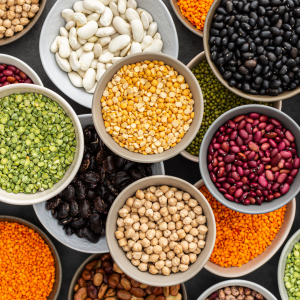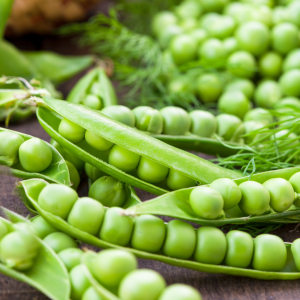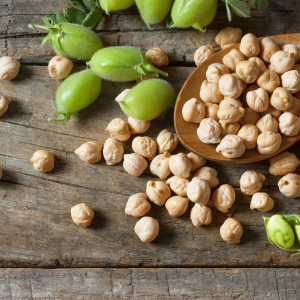This article, written by Doug Evans, Osteopath and Natural Health Practitioner, is one from our archives. It was originally published in True Natural Health in 2016.
Legumes are great for our health. This group includes all the beans and peas, such as lentils, chickpeas, baked beans and soya beans (which are particularly beneficial).
All the longest living, healthy populations share one outstanding common dietary factor – they eat legumes/peas several times a week. In fact the greater the proportion of protein obtained from legumes, the healthier they tend to be. If you live and eat as they do, you can expect lowered risks of cardiovascular disease, cancer, diabetes, osteoporosis, menopausal problems and even dementia – just like the peoples of Okinawa, rural China, Azerbaijan, Tarahumara and Hunza Land.
What is it about legumes that would explain their health advantages?
1. The Protein Advantage
Legumes are a rich source of high-quality protein that is low in fat.
Containing a good balance of all the essential amino acids, soya beans have a higher level of protein than lean steak. The following are the raw dry-weight protein contents, except where shown:
Soybeans 31% 
Tofu (moist state) 7%
Broad beans, green 7%
Lentils 24%
Split peas 23%
Chickpeas 16%
Kidney beans 22%
Peas, green 6%
Navy beans (used in baked beans) 22%
Lima beans 21%
For comparison, lean steak protein content is approximately 21%
Another advantage of legumes is that this kind of protein, unlike animal protein, doesn’t cause loss of calcium from our bones. They also provide protection against cardiovascular disease and some forms of cancer.
2. The High Fibre Advantage
Fibre in one cup of dried:
Soya beans 17 gm Split peas 16 gm 
Broad beans 9 gm Peas 5 gm
Chickpeas 12 gm
Legumes compare well with other high-fibre foods:
Berries 8 gm Broccoli 5 gm
Oats 8 gm Spinach 4 gm
Fibre in unprocessed plant foods including legumes, is known to reduce the risk of cancer, specifically of the large intestines. Fibre helps make legumes low-GI foods, which are great for stabilising blood sugar level problems. It also reduces the risk of cardiovascular disease, partially by drawing cholesterol out of the body.
All animal products – meat, eggs and dairy – do not contain fibre.
3. The Mineral Advantage
Legumes are a rich source of minerals, particularly calcium and iron.
Milligrams per 100 gm portion:
Calcium Iron
Soya beans 180 9.5
Chickpeas 120 5.5
Although red meat is a rich source of iron it is a very poor source of calcium. Dairy products on the other hand are a reasonable source of calcium, but are low in iron.
4. The Phytoestrogen Advantage
Legumes are the richest source of phytoestrogens (plant oestrogens) which are often referred to as flavonoids, isoflavones, lignans, etc. Soya is exceptionally high.
A diet high in phytoestrogens has been found to:
- Reduce menstrual and menopausal problems. Just by including some legumes in your diet daily you can reduce hot flushes.
- Lower the incidence of cancers:
particularly breast cancer – and reduce the likelihood of its return; also prostate and colon cancer.
It has also been firmly established that it is not only safe, but also provides extra benefit to include soy (beans, tofu, tempeh) in your diet, if you have or have had breast cancer.
iii. Reduce cardiovascular disease – most likely by lowering harmful cholesterol and triglycerides.
- Increase the density and strength of bone, that is, less osteoporosis.
In their groundbreaking study of the Okinawan people (islands in the southernmost part of Japan), Drs Wilcox and Suzuki discovered that soya products, that is, tofu, tempeh, beans, etc, were a significant factor in keeping bones strong and reducing the incidence of breast cancer. Furthermore, they found that the introduction of soya products (which included soya milk) into the diets of Americans at similar levels “resulted in significant increases in osteocalcin, a blood marker for bone formation,” that is, it stimulated bone regeneration.
The Okinawans are renowned for currently being the longest-living, healthiest people on Earth, with low levels of heart disease, cancer (breast cancer was almost unknown), diabetes and dementia, and with exceptionally strong bones (even though they seldom eat dairy products).
5. The Arginine Advantage
Peas and other legumes are one of the richest sources of arginine, so there is certainly no need to take it as a supplement. Arginine is used by the cells lining the arteries to produce nitric oxide. Nitric oxide helps keep the blood flowing through the arteries by relaxing them to stay open, and making the endothelium surface (inner lining) slippery smooth. This is vital in preventing and reversing cardiovascular disease.
Most fats and oils in the Modern Australian Diet (MAD), namely processed fats, trans fats, heated oils, animal and saturated fats all suppress nitric oxide production.
6. Environmental Advantage
Legume production not only requires less energy from fossil fuels compared to animal products, but also directly reduces carbon dioxide in the atmosphere. Legumes do this because, like all plants, they absorb CO2 from the atmosphere and release oxygen. Scientists are also impressed by their ‘nitrogen fixing’ properties – they draw nitrogen from the air and combine it into plant tissue. This enables following crops to grow at faster rates and therefore absorb even more CO2.
The United Nations has determined that the consumption of animal products, especially those intensively raised, comes at a high environmental cost. The UN has calculated that over 50% of the greenhouse effect could be attributed to their production, when fossil fuel expenditure such as refrigeration is included. Furthermore, according to Professor Bruce Kelly, methane produced by cows, for example, is seventy-two times more potent as a greenhouse gas than carbon dioxide.
Some concerns?
If you are not accustomed to eating legumes, introduce them slowly. At first they can be a little difficult to digest for some people, leading to gas production. Prior to cooking, they should be soaked for an hour or longer, according to their size, rinsed, then cooked until soft. This removes most of the trypsin inhibitors (which inhibit the action of digestive enzymes). Many people find that tofu and tempeh are the most easily digested of all.
Some people are allergic to soya beans and their products.
The idea that legumes contain significant levels of so-called ‘anti-nutrients’ is not well founded. Researchers and dieticians tend to shy away from the use of this term, because they have found these ‘anti-nutrients’ to actually be of overall benefit. They include phytates, lectins and saponins.
Phytates in legumes and whole grains do reduce the absorption of minerals, including calcium and iron. However exhaustive studies have shown this effect to be “insignificant.” Moreover, phytates have been found to have beneficial antioxidant effects.
Lectins, like phytohemagglutinin, are harmful in large doses. However, levels are only high enough in red kidney beans to be of any concern. When legumes, including kidney beans, are prepared properly, the phytohemagglutinin and other lectins are degraded or eliminated.
Although saponins, which are found in most plants, are resistant to digestion, any evidence that they may be harmful to human health has not been forthcoming.
If you have been diagnosed as having low thyroid function, then it is advisable to restrict your soya intake to no more than twice per week.
Despite some recent bad press, particularly from ill-informed Paleo Diet advocates, legumes are proven to be nutritious and beneficial. For optimal health a variety of legumes could play an important part in your diet.
Give peas a chance!
Doug Evans provides supervision for fasting. Doug was a practitioner at the now closed Hopewood Health Retreat. He has had 40 years experience in supervising nutritional programs and therapeutic fasting, including 22 years at Hopewood Health Retreat. Set in Bundeena, comfortable accommodation is provided among trees and quiet garden setting for your fast. Modest fees for daily consultations, monitoring tests, access to health library and healthy lifestyle talks. Plant-based meals for preparing and breaking of fast are also provided.
Bookings via Doug : [email protected] or 0416 254 409
Would you like access to more articles like this? Natural Health Society members receive four copies of True Natural Health every year, and have access to the digital back catalogue of over 20 years of publications. Unlock access to all of our articles and member benefits from just $36 per year! Subscribe | Natural Health Society
